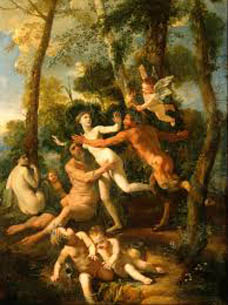Product Description
Gorham T.B. Starr Important Sterling “Macy” Renaissance Revival Pitcher 1893


GORHAM MFG. CO SILVERSMITHS Providence, RI
THEODORE B. STARR Retailer
Renaissance Revival pitcher 1893
A highly important Gorham sterling pitcher chased with mythological faces, putti and various scrolling foliate patterns, the handle in the form of Pan with four sphinx figures supporting the base, all with elaborate and exquisite hand chasing and repousse throughout. Extremely fine original condition with original gilded interior.
Marks: Lion, Anchor, G (Gorham silver touch marks), EX. (Exhibition), Theodore B. Starr, 6 pint, Sterling, 1805, double circle touch mark (date mark for 1893)
Provenance: Private Collection, New York; Private Collection Florida from 1984 to 2009; directly descended in the family of Thomas H. Macy (founder of Nantucket) prior to 1984
Weight: 74 troy oz.
H: 13″ x W: 10″ x D: 7″
Gorham T.B. Starr Important Sterling “Macy” Renaissance Revival Pitcher 1893
WOLFGANG GESSL (b. 1949) Austria / Sweden
Cone Teapot 1996 (designed 1995)
Hand wrought and hand hammered silver cone shaped covered pitcher form with a green PVC handle and spout over silver cylindrical arching forms
Marks: Wolfgang Gessl (script impressed signature), WO.GE (in a rectangle), Swedish assay mark for Stockholm, 925 (silver guarantee in a rectangle), X10 (in a rectangle), 2/9 GD 452
Illustrated: Gold and Silversmith Wolfgang Gessl: Exceeding Geometry, Kerstin Wickman, p. 19.
H: 8 3/8” x W: 8 ½” x Dia base: 5 ¼”
This is No. 2 out of the edition of 9 models.
Price: $22,500
Wolfgang Gessl was born in 1949 in Vienna, Austria and trained as a goldsmith with Professor Hans Angerbauer. Upon moving to Sweden, Gessl studied under the eminent silversmith Sigurd Persson at Konstfack, the National University of Art, Craft and Design in Stockholm, Sweden.
Wolfgang Gessl has had fifteen solo exhibitions including shows at The National Museum, Stockholm and The Royal College of Art in London. His metalwork has been widely exhibited in Sweden, Europe and the U.S and his pieces can be found in many private collections throughout the world. He has taught at Konstfack for more than twenty-four years, and continues to live and work in Stockholm.
